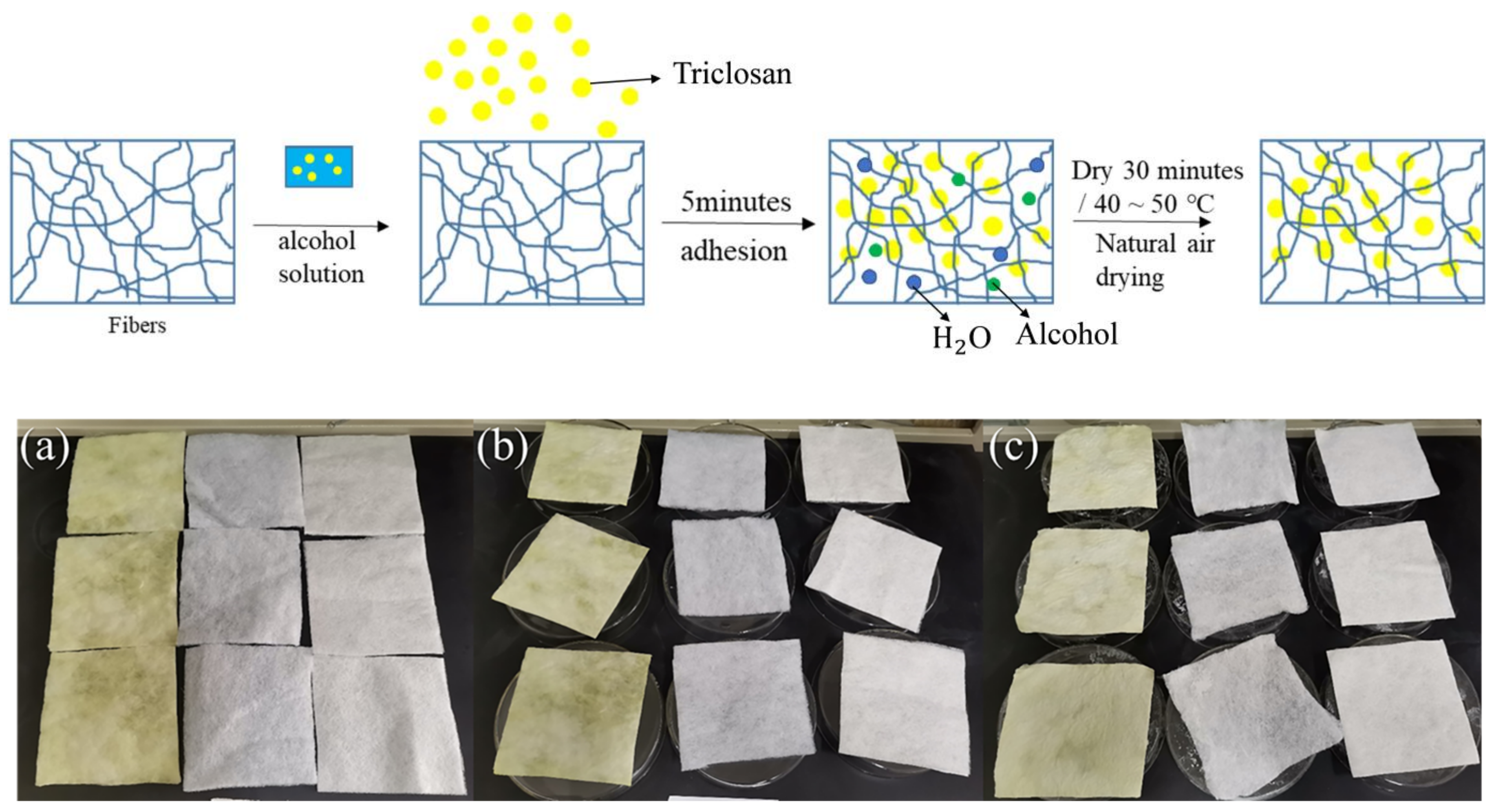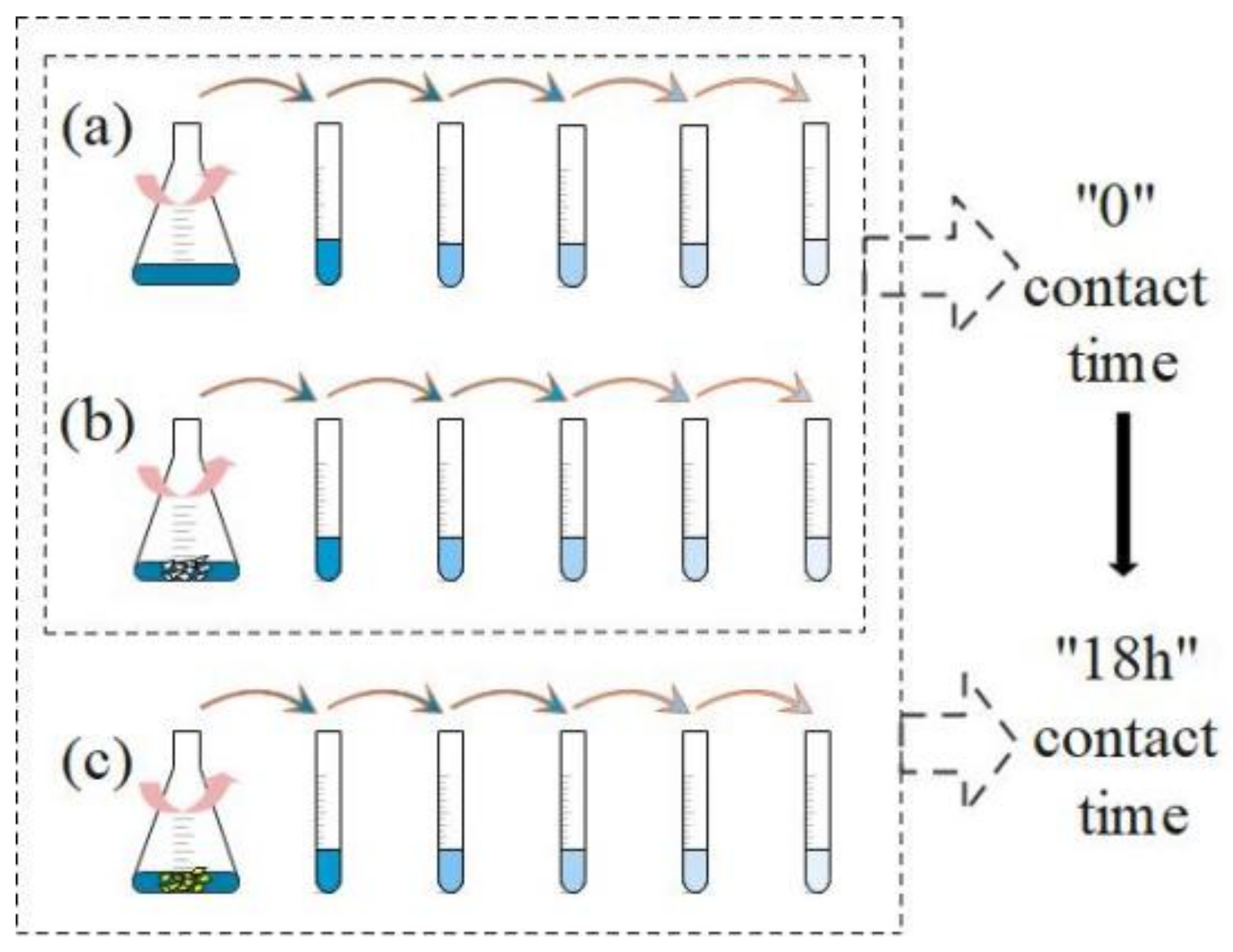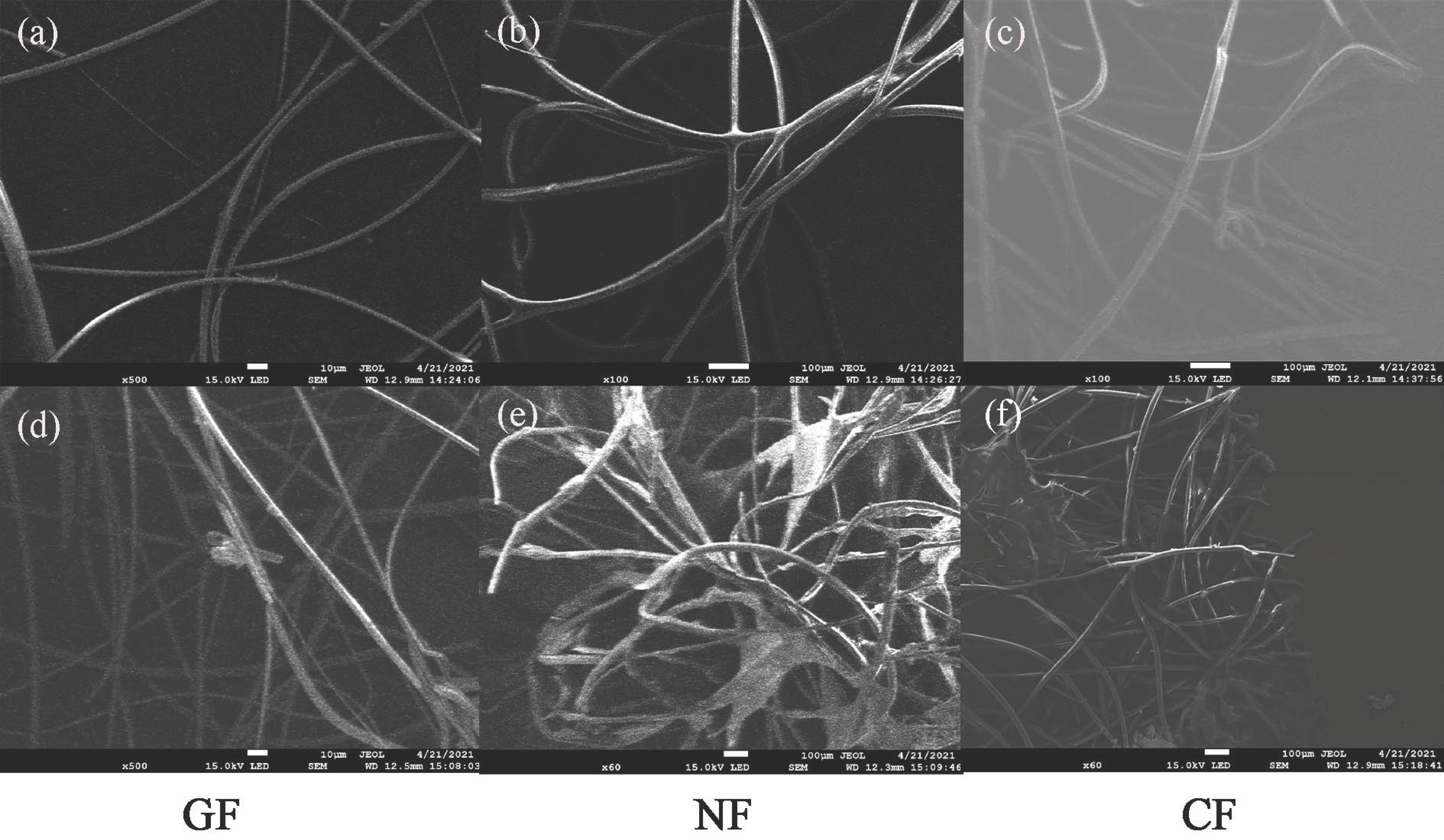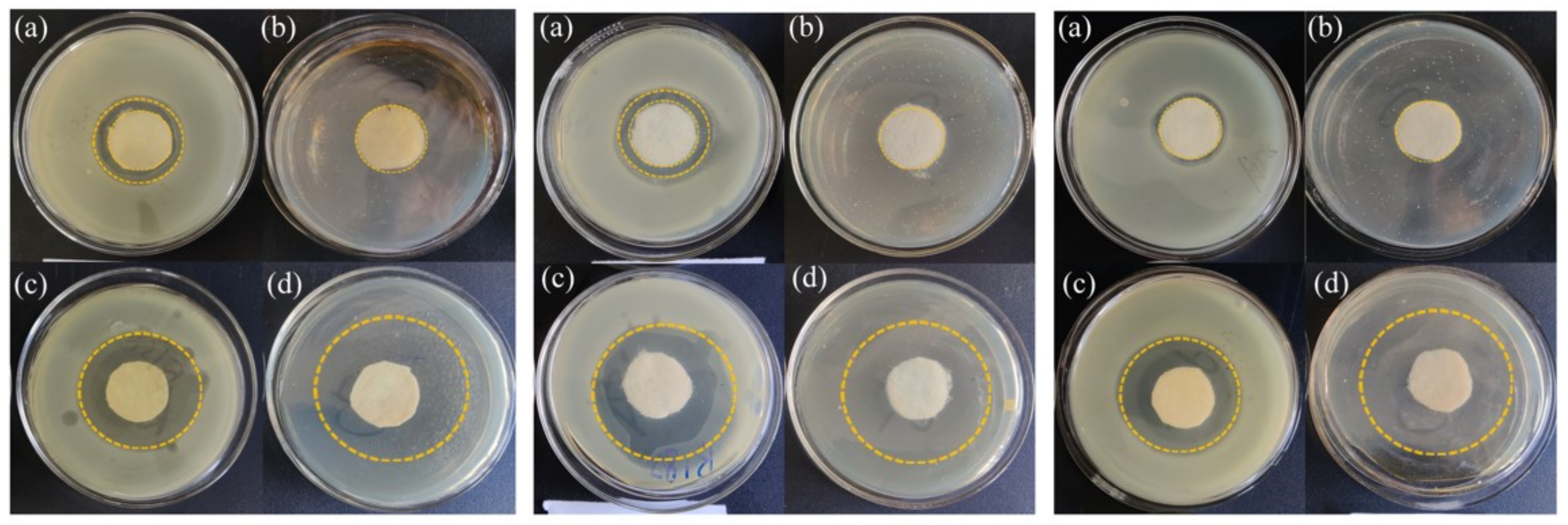Antibacterial Capability of Air Filter Fiber Materials Treated with Triclosan against Indoor Environmental Microbes
Abstract
:1. Introduction
2. Materials and Methods
2.1. Preparation of Antibacterial Fibers
2.2. Test Materials
2.3. Qualitative Antibacterial Efficiency Assays
2.4. Quantitative Antibacterial Efficiency Assays
2.5. Qualitative Evaluation on Antimicrobial Capability
2.6. Quantitative Evaluation on Antibacterial Capability
3. Results and Discussion
3.1. Antibacterial Filter Material Performance
3.2. Antibacterial Capability of the Qualitative Assays
3.3. Antibacterial Capability of the Quantitative Assays
4. Conclusions
Author Contributions
Funding
Institutional Review Board Statement
Informed Consent Statement
Data Availability Statement
Acknowledgments
Conflicts of Interest
References
- World Health Organization (WHO). Available online: https://www.who.int (accessed on 17 June 2022).
- Yang, Y.; Zhang, H.; Nunayon, S.S.; Chan, V.; Lai, A.C.K. Disinfection efficacy of ultraviolet germicidal irradiation on airborne bacteria in ventilation ducts. Indoor Air 2018, 28, 806–817. [Google Scholar] [CrossRef] [PubMed]
- Wu, Y.; Yao, M. Inactivation of bacteria and fungus aerosols using microwave irradiation. J. Aerosol Sci. 2010, 41, 682–693. [Google Scholar] [CrossRef]
- Bahri, M.; Haghighat, F. Plasma-based indoor air cleaning technologies: The state of the art-review. CLEAN—Soil Air Water 2014, 42, 1667–1680. [Google Scholar] [CrossRef]
- Lee, S.H. Development of Photocatalyst Plasma Air Cleaning Filter Used in Air Conditioner. J. Adv. Oxid. Technol. 2016, 6, 13–16. [Google Scholar] [CrossRef]
- Abdulla, N.K.; Siddiqui, S.I.; Fatima, B.; Sultana, R.; Tara, N.; Hashmi, A.A.; Ahmad, R.; Mohsin, M.; Nirala, K.R.; Linh, T.N.; et al. Silver based hybrid nanocomposite: A novel antibacterial material for water cleansing. J. Clean. Prod. 2021, 284, 124746. [Google Scholar] [CrossRef]
- Balagna, C.; Perero, S.; Bosco, F.; Mollea, C.; Irfan, M.; Ferraris, M. Antipathogen nanostructured coating for air filters. Appl. Surf. Sci. 2020, 508, 145283. [Google Scholar] [CrossRef]
- Chowdhury, M.N.K.; Beg, M.D.H.; Khan, M.R.; Mina, M.F. Synthesis of copper nanoparticles and their antimicrobial performances in natural fibres. Mater. Lett. 2013, 98, 26–29. [Google Scholar] [CrossRef] [Green Version]
- Cao, Y.; Xin, B.; Wu, X.; Du, W. Research on progress and possibility of electrospining of native cellulose and preparation of copper-based antimicrobial fiber. Adv. Mater. Res. 2014, 850–851, 53–56. [Google Scholar] [CrossRef]
- Salussoglia, A.I.P.; de Souza, C.W.O.; Tanabe, E.H.; Lopes Aguiar, M. Evaluation of filter media covered with spun fibres and containing thyme essential oil with antimicrobial properties. Environ. Technol. 2020, 43, 301–310. [Google Scholar] [CrossRef]
- Asanović, K.; Mihailović, T.; Škundrić, P.; Simović, L. Some Properties of Antimicrobial Coated Knitted Textile Material Evaluation. Text. Res. J. 2010, 80, 1665–1674. [Google Scholar] [CrossRef]
- Sánchez-López, E.; Gomes, D.; Esteruelas, G.; Bonilla, L.; Lopez-Machado, A.L.; Galindo, R.; Cano, A.; Espina, M.; Ettcheto, M.; Camins, A.; et al. Metal-based nanoparticles as antimicrobial agents: An overview. Nanomaterials 2020, 10, 292. [Google Scholar] [CrossRef] [PubMed] [Green Version]
- Kim, S.A.; Moon, H.; Lee, K.; Rhee, M.S. Bactericidal effects of triclosan in soap both in vitro and in vivo. J. Antimicrob. Chemother. 2015, 70, 3345–3352. [Google Scholar] [CrossRef] [PubMed] [Green Version]
- Halla, N.; Fernandes, I.P.; Heleno, S.A.; Costa, P.; Boucherit-Otmani, Z.; Boucherit, K.; Rodrigues, A.E.; Ferreira, L.C.F.R.; Barreiro, M.F. Cosmetics preservation: A review on present strategies. Molecules 2018, 23, 1571. [Google Scholar] [CrossRef] [PubMed] [Green Version]
- Machado, A.H.S.; Garcia, I.M.; Motta, A.D.S.D.; Leitune, V.C.B.; Collares, F.M. Triclosan-loaded chitosan as antibacterial agent for adhesive resin. J. Dent. 2019, 83, 33–39. [Google Scholar] [CrossRef]
- Arslan, N.C.; Atasoy, G.; Altintas, T.; Terzi, C. Effect of triclosan-coated sutures on surgical site infections in pilonidal disease: Prospective randomized study. Int. J. Colorectal Dis. 2018, 33, 1445–1452. [Google Scholar] [CrossRef]
- Wang, Z.X.; Jiang, C.P.; Cao, Y.; Ding, Y.T. Systematic review and meta-analysis of triclosan-coated sutures for the prevention of surgical-site infection. Br. J. Surg. 2013, 100, 465–473. [Google Scholar] [CrossRef]
- Aminu, N.; Chan, S.Y.; Yam, M.F.; Toh, S.M. A dual-action chitosan-based nanogel system of triclosan and flurbiprofen for localised treatment of periodontitis. Int. J. Pharm. 2019, 570, 118659. [Google Scholar] [CrossRef]
- Paula, A.B.; Alonso, R.C.B.; Taparelli, J.R.; Camassari, J.R.; Innocentini-Mei, L.H.; Correr-Sobrinho, L.; Puppin-Rontani, R.M. Influence of the incorporation of triclosan methacrylate on the physical properties and antibacterial activity of resin composite. J. Appl. Oral Sci. 2019, 27, 1–8. [Google Scholar] [CrossRef]
- Guo, X.; Cheng, Q.; Yu, G.; Wang, H.; Tian, Z.; Shi, Z.; Cui, Z.; Zhu, S. The functions of hydrophobic elastic polyurethane combined with an antibacterial triclosan derivative in the dentin restoration interface. J. Mech. Behav. Biomed. Mater. 2020, 102, 103471. [Google Scholar] [CrossRef] [PubMed]
- Petersen, R.C. Computational conformational antimicrobial analysis developing mechanomolecular theory for polymer biomaterials in materials science and engineering. Int. J. Comput. Mater. Sci. Eng. 2014, 3, 48. [Google Scholar] [CrossRef]
- Kayaci, F.; Umu, O.C.O.; Tekinay, T.; Uyar, T. Antibacterial electrospun poly(lactic acid) (PLA) nanofibrous webs incorporating triclosan/cyclodextrin inclusion complexes. Agric. Food Chem. 2013, 16, 3901–3908. [Google Scholar] [CrossRef]
- Lee, J.H.; Park, S.H.; Kim, S.H. Fabrication of bio-based polyurethane nanofibers incorporated with a triclosan/cyclodextrin complex for antibacterial applications. RSC Adv. 2020, 10, 3450–3458. [Google Scholar] [CrossRef] [PubMed]
- Novikov, M.; Thong, K.L.; Zazali, N.I.M.; Hamid, S.B.A. Treatment of Cotton by β-Cyclodextrin/Triclosan Inclusion Complex and Factors Affecting Antimicrobial Properties. Fibers Polym. 2018, 19, 548–560. [Google Scholar] [CrossRef]
- Cui, H.; Wu, X.; Zhang, D.; Zhang, J.; Xiao, H.; Chen, Y. Thermotolerance and antibacterial properties of MgO-triclosan nanocomposites. Procedia Eng. 2015, 102, 410–416. [Google Scholar] [CrossRef] [Green Version]
- Karaszewska, A.; Kamińska, I.; Kiwała, M.; Gadzinowski, M.; Gosecki, M.; Slomkowski, S. Preparation and properties of textile materials modified with triclosan-loaded polylactide microparticles. Polym. Adv. Technol. 2017, 28, 1185–1193. [Google Scholar] [CrossRef]
- Peila, R.; Vineis, C.; Varesano, A.; Ferri, A. Different methods for β-cyclodextrin/triclosan complexation as antibacterial treatment of cellulose substrates. Cellulose 2013, 20, 2115–2123. [Google Scholar] [CrossRef]
- Escalada, M.G.; Russell, A.D.; Maillard, J.Y.; Ochs, D. Triclosan bacteria interactions: Single or multiple target sites. Lett. Appl. Microbiol. 2005, 41, 476–481. [Google Scholar] [CrossRef]
- Peila, R.; Migliavacca, G.; Aimone, F.; Ferri, A.; Sicardi, S. A comparison of analytical methods for the quantification of a reactive β-cyclodextrin fixed onto cotton yarns. Cellulose 2012, 19, 1097–1105. [Google Scholar] [CrossRef]
- Orhan, M. Triclosan applications for biocidal functionalization of polyester and cotton surfaces. J. Eng. Fibers Fabr. 2020, 15, 1558925020940104. [Google Scholar] [CrossRef]
- Orhan, M.; Kut, D.; Güneşoğlu, C. Improving the antibacterial activity of cotton fabrics finished with triclosan by the use of 1, 2, 3, 4-butanetetracarboxylic acid and citric acid. Appl. Polym. Sci. 2009, 111, 1344–1352. [Google Scholar] [CrossRef]
- Celebioglu, A.; Umu, O.C.O.; Tekinay, T.; Uyar, T. Antibacterial electrospun nanofibers from triclosan/cyclodextrin inclusion complexes. Colloids Surf. B Biointerfaces 2014, 116, 612–619. [Google Scholar] [CrossRef] [PubMed]
- Goetzendorf-Grabowska, B.; Polus, Z.; Kiwała, M.; Karaszewska, A.; Kamińska, I.; Mączka, I. Antibacterial air filter nonwovens modifed by poly(lactide) microspheres containing triclosan. Fibres Text. 2015, 23, 114–119. [Google Scholar]
- EN 1822-3-2009; High Efficiency Air Filters-Part 3: Testing Flat Sheet Filter Media. European Committee for Standardization: Brussels, Belgium, 2009.
- ISO20645-2004; Textile Fabrics—Determination of Antibacterial Activity—Agar Diffusion Plate Test. International Organization for Standardization (ISO): Geneva, Switzerland, 2004.
- ASTME2149-2020; Test Method for Determining the Antibacterial Activity of Antimicrobial Agents Under Dynamic Contact Conditions. American Society for Testing and Materials (ASTM): West Conshohocken, PA, USA, 2020.
- GB/T20944.3-2008; Textiles-Evaluation for Antibacterial Activity-Part 3: Shake Flask Method. Standardization Administration of China (SAC): Beijing, China, 2008. (In Chinese)
- Yang, J.; Wang, Z.; Wu, J.; Hao, L.; Tian, T.; Lin, S. Study on an air filter material immobilized with bio-antimicrobials. Adv. Mater. Res. 2011, 152–153, 1519–1524. [Google Scholar] [CrossRef]
- Lee, H.K. Electrical sterilization of Escherichia coli by electrostatic atomization. J. Electrost. 2001, 51–52, 71–75. [Google Scholar] [CrossRef]
- Sanbhal, N.; Mao, Y.; Sun, G.; Li, Y.; Peerzada, M.; Wang, L. Preparation and characterization of antibacterial polypropylene meshes with covalently incorporated β-cyclodextrins and captured antimicrobial agent for hernia repair. Polymers 2018, 10, 58. [Google Scholar] [CrossRef] [Green Version]
- Kamalipour, J.; Masoomi, M.; Khonakdar, H.A.; Razavi, S.M.R. Preparation and release study of Triclosan in polyethylene/Triclosan anti-bacterial blend. Colloids Surf. B Biointerfaces 2016, 145, 891–898. [Google Scholar] [CrossRef]




| Coupons | E. coli | S. albus | |||
|---|---|---|---|---|---|
| GF | TT | - | - | ||
| AT | - | - | |||
| NF | TT | - | - | ||
| AT | - | + | |||
| CF | TT | - | - | ||
| AT | - | - | |||
| Coupons | E. coli | S. albus |
|---|---|---|
| GF (TT) | -- | |
| NF (TT) | -- | |
| CF (TT) |
Publisher’s Note: MDPI stays neutral with regard to jurisdictional claims in published maps and institutional affiliations. |
© 2022 by the authors. Licensee MDPI, Basel, Switzerland. This article is an open access article distributed under the terms and conditions of the Creative Commons Attribution (CC BY) license (https://creativecommons.org/licenses/by/4.0/).
Share and Cite
Li, Y.; Miao, Q.; Wang, X. Antibacterial Capability of Air Filter Fiber Materials Treated with Triclosan against Indoor Environmental Microbes. Atmosphere 2022, 13, 1104. https://doi.org/10.3390/atmos13071104
Li Y, Miao Q, Wang X. Antibacterial Capability of Air Filter Fiber Materials Treated with Triclosan against Indoor Environmental Microbes. Atmosphere. 2022; 13(7):1104. https://doi.org/10.3390/atmos13071104
Chicago/Turabian StyleLi, Yanju, Qingqing Miao, and Xinyu Wang. 2022. "Antibacterial Capability of Air Filter Fiber Materials Treated with Triclosan against Indoor Environmental Microbes" Atmosphere 13, no. 7: 1104. https://doi.org/10.3390/atmos13071104
APA StyleLi, Y., Miao, Q., & Wang, X. (2022). Antibacterial Capability of Air Filter Fiber Materials Treated with Triclosan against Indoor Environmental Microbes. Atmosphere, 13(7), 1104. https://doi.org/10.3390/atmos13071104





